Box pruning revisited - part 12 - ASM FTW
Part 12 – ASM FTW
Fasten your seatbelts; this one is going to be a bit bumpy. Last time we were left with unanswered questions and doubts about the quality of the compiler-generated code.
Those who know me probably saw it coming from a mile away: this time we’ll rewrite the loop in assembly. Old-school, baby.
It is not always useful, but it is often informative and eye-opening.
To make things easier, we will limit ourselves to a small part of the loop. We are not going to rewrite the whole function. Just this snippet:
And we’re only going to do the “unsafe” version, since that’s (slightly) less work.
The easiest way to do the conversion is to use inline assembly in Visual Studio (you know now why this whole experiment is using a Win32 project - inline assembly is not supported anymore in Win64 builds).
You just comment out lines and start replacing them with blocks of _asm code. The assembly code there can directly access some of the C++ variables, it’s all rather simple. Sort of.
For example this:
Becomes:
Then this:
Becomes for example:
And once the loop is done and you double-checked it iterates the proper number of times (it’s easy to compare against the C code when both are right there in the same file), you just add the missing bits.
The SIMD overlap test:
…will need some code before the loop to compute the initial address:
And then the actual test inside the loop will be something like:
At this point you don’t immediately write the code to output the pair. First you just increase a counter (using a free register like maybe ebx) and you count the number of overlaps you get. Then you printf the results and compare it to the C code. Is the number correct? Good, then you can now complete the function and actually output the pair. Writing a push_back in assembly is tedious and pointless, so you don’t actually need to do it. Just move the corresponding code to a C function like this:
And then call it from the assembly block, like this:
So there are a couple of subtleties in there.
The called function must have a __cdecl signature, because we sent parameters to it via the stack. Alternatively, compile the whole project with the /Gd compile option (it’s the default anyway).
If you omit __cdecl in the function signature and compile the whole program with the __fastcall convention (/Gr compile option), then it will crash when trying to call “outputPair“.
The parameters are passed in reverse order, that’s the convention. Note how you can directly use the Remap, pairs and RIndex0 variables from the assembly code. They’re all C++ variables, the compiler knows what to do. It’s very convenient. After the call the “add esp, 16” fixes the stack pointer - it’s 16 because we pushed four 4-bytes elements to the stack before calling the function.
Now the function call is wrapped by a pushad/popad couple. It’s the lazy man’s way to save and restore all registers to/from the stack. This makes sure that whatever happens in outputPair, it’s not going to modify the values kept in our CPU registers.
And then the movaps on xmm1 and xmm2 do the same save & restore for the two xmm registers we care about. These ones are easy to forget because most of the time outputPair does not change the xmm registers… but it does when there is a re-allocation within the container. If you are not aware of that, this can be a hard-to-find bug.
Right.
If you put all this together you get this first, “naive” version:
Let’s see how it fares against the questions raised in part 11.
Question 1 was: why write the code in such a way that it destroys the constant box?
Answer: because we don’t have a choice. We do the same in our assembly version: xmm3 is also the constant box, and it’s also destroyed by the cmpltps instruction, exactly like in the compiler-generated version. It turns out that there is no alternative. We used this intrinsic:
_mm_cmpgt_ps
But what we got in the assembly was:
cmpltps
Do you spot the difference? It’s “greater than” in the intrinsic, and “lower than” in the actual assembly. It’s the intrinsic trap again. You can see it here for example. The intrinsic is marked as CMPLTPSr, which means there is no actual cmpgtps instruction: it does not exist. So the compiler uses the “reverse” instruction instead (CMPLTPS) and swaps the arguments. That gives birth to the code we saw.
Beyond that, even if cmpgtps would exist, one way or another the comparison instruction would overwrite the contents of one register. It can be either our constant box, or the freshly loaded data for the new box. And both alternatives come down to the same amount of instructions: one load, and one cmp. We cannot do less.
So, it’s a wash. The compiler was not to blame here, our question was simply naïve.
———-
Question 2 was: why reload the constant box from the stack? Why not keeping it in a register? The whole loop only uses two xmm registers (!) so it’s not like there’s a shortage of them.
=> We fixed this. The constant box is now kept in xmm2, which is only saved and restored when an overlap occurs. We win.
———-
Question 3 was: why do you reload it from the stack each time? It’s a constant for the whole loop. There are free available xmm registers. Just put it in xmm2, keep it there, and the “movss” instruction above just vanishes.
=> We fixed this. This was about MaxLimit, which is now kept in xmm1. The “movss” disappeared indeed. We win.
———-
Question 4 was about the BoxListX array being constantly written to the stack (and sometimes reloaded from it, with VC10).
=> We fixed this. It’s now kept in the esi register at all time. We win.
Question 5 was: why do you save edx to the stack all the time (address 003E3028)? Why don’t you just save and restore it only when an overlap actually occurs?
Question 6 was: same question for ecx.
=> We fixed this. We don’t write any CPU registers to the stack, unless an overlap occurs. We win.
———-
Sounds good!
The most often used codepath is now 10 instructions, compared to 13 before. Exciting!
But then you run the benchmark and…
Home PC:
Complete test (brute force): found 11811 intersections in 781774 K-cycles.
15193 K-cycles.
14574 K-cycles.
14399 K-cycles.
14310 K-cycles.
14619 K-cycles.
14366 K-cycles.
14310 K-cycles.
14322 K-cycles.
14310 K-cycles.
14310 K-cycles.
14309 K-cycles.
14740 K-cycles.
14346 K-cycles.
14311 K-cycles.
14375 K-cycles.
14374 K-cycles.
Complete test (box pruning): found 11715 intersections in 14309 K-cycles.
Office PC:
Complete test (brute force): found 11811 intersections in 812640 K-cycles.
13814 K-cycles.
13636 K-cycles.
13544 K-cycles.
13745 K-cycles.
13547 K-cycles.
13610 K-cycles.
13549 K-cycles.
13423 K-cycles.
12929 K-cycles.
13498 K-cycles.
13052 K-cycles.
13213 K-cycles.
12917 K-cycles.
13166 K-cycles.
13510 K-cycles.
13817 K-cycles.
Complete test (box pruning): found 11715 intersections in 12917 K-cycles.
The gains are summarized here:
|
Home PC |
Timings (K-Cycles) |
Delta (K-Cycles) |
Speedup |
Overall X factor |
|
(Version1) |
(101662) |
|
|
|
|
Version2 - base |
98822 |
0 |
0% |
1.0 |
|
Version3 |
93138 |
~5600 |
~5% |
~1.06 |
|
Version4 |
81834 |
~11000 |
~12% |
~1.20 |
|
Version5 |
78140 |
~3600 |
~4% |
~1.26 |
|
Version6a |
60579 |
~17000 |
~22% |
~1.63 |
|
Version6b |
41605 |
~18000 |
~31% |
~2.37 |
|
(Version7) |
(40906) |
- |
- |
- |
|
(Version8) |
(31383) |
(~10000) |
(~24%) |
(~3.14) |
|
Version9a |
34486 |
~7100 |
~17% |
~2.86 |
|
Version9b - unsafe |
32477 |
~2000 |
~5% |
~3.04 |
|
Version9b - safe |
32565 |
~1900 |
~5% |
~3.03 |
|
Version9c - unsafe |
16223 |
~16000 |
~50% |
~6.09 |
|
Version9c - safe |
14802 |
~17000 |
~54% |
~6.67 |
|
(Version10) |
(16667) |
- |
- |
- |
|
Version11 - unsafe |
14372 |
~1800 |
~11% |
~6.87 |
|
Version11 - safe |
14512 |
~200 |
~2% |
~6.80 |
|
Version12 |
14309 |
- |
- |
~6.90 |
|
Office PC |
Timings (K-Cycles) |
Delta (K-Cycles) |
Speedup |
Overall X factor |
|
(Version1) |
(96203) |
|
|
|
|
Version2 - base |
92885 |
0 |
0% |
1.0 |
|
Version3 |
88352 |
~4500 |
~5% |
~1.05 |
|
Version4 |
77156 |
~11000 |
~12% |
~1.20 |
|
Version5 |
73778 |
~3300 |
~4% |
~1.25 |
|
Version6a |
58451 |
~15000 |
~20% |
~1.58 |
|
Version6b |
45634 |
~12000 |
~21% |
~2.03 |
|
(Version7) |
(43987) |
- |
- |
- |
|
(Version8) |
(29083) |
(~16000) |
(~36%) |
(~3.19) |
|
Version9a |
31864 |
~13000 |
~30% |
~2.91 |
|
Version9b - unsafe |
15097 |
~16000 |
~52% |
~6.15 |
|
Version9b - safe |
15116 |
~16000 |
~52% |
~6.14 |
|
Version9c - unsafe |
12707 |
~2300 |
~15% |
~7.30 |
|
Version9c - safe |
12562 |
~2500 |
~16% |
~7.39 |
|
(Version10) |
(15648) |
- |
- |
- |
|
Version11 - unsafe |
12570 |
~100 |
~1% |
~7.38 |
|
Version11 - safe |
12611 |
- |
- |
~7.36 |
|
Version12 |
12917 |
- |
- |
~7.19 |
…it’s pretty much exactly the same speed as before, or even marginally slower.
You didn’t think it would be that easy, did you?
It’s not.
But it was important to go through this process: it gives a better understanding of why the compiler made certain choices, and it shows why conventional wisdom says that it is hard to beat the compiler these days. Most of the time, the hand-written version is indeed slower than the compiler-generated version.
That would be the conclusion you would stop at, if this would be the conclusion you wanted to reach.
Well…
Old habits die hard and ex-demomakers cannot stop here I’m afraid.
The reality is that you cannot do worse than the compiler: just start from the compiler-generated version. How can you do worse if you copy what it did and improve from there?
The real benefit of the assembly version is that it opens the door for more tinkering. It’s pretty hard (if not impossible) to make the compiler generate exactly what you want, to create various experiments. So for example you cannot easily remove a specific instruction in the code flow to check its impact on performance. But the assembly version lets you do whatever you want, without interference.
And we’re certainly going to exploit this.
What we did see so far, fair enough, is that our naive ideas about this code were wrong: keeping things in registers and avoiding spilling to the stack is apparently not such a big deal. This much is very true: these days it’s very difficult to foresee how a change will affect performance. But that is exactly why the assembly version helps: it allows you to do very precise experiments, and see the impact of each line.
For example you can comment out the part that outputs the pairs, without the optimizing compiler removing the whole SIMD test when it discovers that it now can.
Do that and you discover that the timings barely change. These writes to output overlapping pairs are virtually free.
Continue doing this meticulously, and you will soon reach that one:
inc edi // Index1++
Comment it out, and…
Complete test (brute force): found 11811 intersections in 822828 K-cycles.
11727 K-cycles.
10996 K-cycles.
11431 K-cycles.
10930 K-cycles.
10984 K-cycles.
11271 K-cycles.
11632 K-cycles.
11412 K-cycles.
11621 K-cycles.
12076 K-cycles.
11480 K-cycles.
11624 K-cycles.
11244 K-cycles.
10963 K-cycles.
11492 K-cycles.
11074 K-cycles.
Complete test (box pruning): found 11715 intersections in 10930 K-cycles.
Wo-ah.
WO-AH.
This is now significantly faster, even though edi is only used when we output pairs. So it could be that not increasing edi removes some cache misses, because we use it as an index in the remap table, and if it’s constant we remap the same index all the time, so, less cache misses. Except we just saw that removing the whole block of code writing out the pairs barely had an impact on performance. Hmmm.
So, scratching head, observing, formulating a theory: is that because we use “inc” instead of “add” ? Testing: nope, replacing “inc edi” with “add edi, 1” doesn’t change anything.
More theories led to more tests that didn’t reveal anything. For some reason, increasing edi there is costly. I admit I still don’t know why.
But at the end of the day, the “why” doesn’t matter much. At this level it’s a bit like quantum mechanics: there are a lot of weird rules at play, weird things happen, and trying to explain “why” in an intuitive way doesn’t always work. What matters more is that the assembly version allowed us to discover a weakness in the code, and we would never have seen that in the C++ version, because it was only:
Index1++;
Which gave birth to three different adds:
003E301C add ecx,8
003E301F add edx,4
003E3022 add edi,10h
We don’t have any control over these assembly adds in the C++ code, because there’s only one line there, and we cannot just remove it without breaking the whole loop. The assembly version however gives us control over the atomic instructions, for more fine-grained experiments. Experimenting at C++ level is like playing the piano with boxing gloves: you end up creating noise rather than music.
Note also how that one was found by accident: random changes. Random mutations, as if we’d be running a genetic algorithm on the code sequence. Random jumps to get out of a local minimum. I remember a competition that once took place in the office between me and a co-worker. At some point I came up with a counter-intuitive piece of code, full of branches, that turned out to be faster than all the branchless versions we had tried before. That co-worker told me something I’d never forget: “I would never have tried that!“. It was said with a tone clearly expressing his disgust at what looked like a terrible idea and a terrible piece of code. And that’s the lesson here: assumptions are the mother of all fuckups, you know that quote. When you’re that close to the metal, sometimes it’s good to forget what you think you know, and just try things. Even stupid things. Especially stupid things.
Sometimes, like here, it works. Increasing edi is slow? Fine, I don’t need to know why: I just won’t do it.
With this clear goal in mind, writing a new version doesn’t take long.
The new strategy is to use a single offset (ecx) to address both the BoxListX and BoxListYZ arrays. Then, when an overlap occurs, we recompute the box index from that single offset, instead of increasing a counter each time. As a result, we can replace the inc / add / add from the previous version with just one add. The most used codepath is now only 8 instructions (compared to the 13 from the compiler-generated version), and most importantly we don’t touch edi anymore.
So, did that work this time?
Yep:
Home PC:
Complete test (brute force): found 11811 intersections in 781991 K-cycles.
15514 K-cycles.
11767 K-cycles.
11733 K-cycles.
11734 K-cycles.
12045 K-cycles.
11758 K-cycles.
11737 K-cycles.
11736 K-cycles.
11748 K-cycles.
11744 K-cycles.
11733 K-cycles.
11736 K-cycles.
11755 K-cycles.
11758 K-cycles.
11736 K-cycles.
11731 K-cycles.
Complete test (box pruning): found 11725 intersections in 11731 K-cycles.
Office PC:
Complete test (brute force): found 11811 intersections in 820108 K-cycles.
10815 K-cycles.
10923 K-cycles.
10528 K-cycles.
10509 K-cycles.
10804 K-cycles.
10524 K-cycles.
10921 K-cycles.
10027 K-cycles.
10815 K-cycles.
10792 K-cycles.
10019 K-cycles.
10016 K-cycles.
10983 K-cycles.
10016 K-cycles.
10495 K-cycles.
10014 K-cycles.
Complete test (box pruning): found 11725 intersections in 10014 K-cycles.
The gains are summarized here:
|
Home PC |
Timings (K-Cycles) |
Delta (K-Cycles) |
Speedup |
Overall X factor |
|
(Version1) |
(101662) |
|
|
|
|
Version2 - base |
98822 |
0 |
0% |
1.0 |
|
Version3 |
93138 |
~5600 |
~5% |
~1.06 |
|
Version4 |
81834 |
~11000 |
~12% |
~1.20 |
|
Version5 |
78140 |
~3600 |
~4% |
~1.26 |
|
Version6a |
60579 |
~17000 |
~22% |
~1.63 |
|
Version6b |
41605 |
~18000 |
~31% |
~2.37 |
|
(Version7) |
(40906) |
- |
- |
- |
|
(Version8) |
(31383) |
(~10000) |
(~24%) |
(~3.14) |
|
Version9a |
34486 |
~7100 |
~17% |
~2.86 |
|
Version9b - unsafe |
32477 |
~2000 |
~5% |
~3.04 |
|
Version9b - safe |
32565 |
~1900 |
~5% |
~3.03 |
|
Version9c - unsafe |
16223 |
~16000 |
~50% |
~6.09 |
|
Version9c - safe |
14802 |
~17000 |
~54% |
~6.67 |
|
(Version10) |
(16667) |
- |
- |
- |
|
Version11 - unsafe |
14372 |
~1800 |
~11% |
~6.87 |
|
Version11 - safe |
14512 |
~200 |
~2% |
~6.80 |
|
Version12 - first |
14309 |
- |
- |
~6.90 |
|
Version12 - second |
11731 |
~2600 |
~18% |
~8.42 |
|
Office PC |
Timings (K-Cycles) |
Delta (K-Cycles) |
Speedup |
Overall X factor |
|
(Version1) |
(96203) |
|
|
|
|
Version2 - base |
92885 |
0 |
0% |
1.0 |
|
Version3 |
88352 |
~4500 |
~5% |
~1.05 |
|
Version4 |
77156 |
~11000 |
~12% |
~1.20 |
|
Version5 |
73778 |
~3300 |
~4% |
~1.25 |
|
Version6a |
58451 |
~15000 |
~20% |
~1.58 |
|
Version6b |
45634 |
~12000 |
~21% |
~2.03 |
|
(Version7) |
(43987) |
- |
- |
- |
|
(Version8) |
(29083) |
(~16000) |
(~36%) |
(~3.19) |
|
Version9a |
31864 |
~13000 |
~30% |
~2.91 |
|
Version9b - unsafe |
15097 |
~16000 |
~52% |
~6.15 |
|
Version9b - safe |
15116 |
~16000 |
~52% |
~6.14 |
|
Version9c - unsafe |
12707 |
~2300 |
~15% |
~7.30 |
|
Version9c - safe |
12562 |
~2500 |
~16% |
~7.39 |
|
(Version10) |
(15648) |
- |
- |
- |
|
Version11 - unsafe |
12570 |
~100 |
~1% |
~7.38 |
|
Version11 - safe |
12611 |
- |
- |
~7.36 |
|
Version12 - first |
12917 |
- |
- |
~7.19 |
|
Version12 - second |
10014 |
~2500 |
~20% |
~9.27 |
There you go! We’re getting close to a 10X speedup…
Who said hand-written assembly cannot beat the compiler?
Now it would be tempting to be smug about it, conclude that “assembly rules” or something, that compilers are “lame”, or any of the many things ex demo-coders are fond of saying.
But things in the real world are not that black-or-white, as I will demonstrate in the next post.
Stay tuned. We are not done.
What we learnt:
An assembly version is often useful to let us play with the code, experiment, and discover potential performance gains that wouldn’t have been easy to spot with the C++ version.
Hand-written assembly can still be faster than the compiler-generated version. Or so it seems.
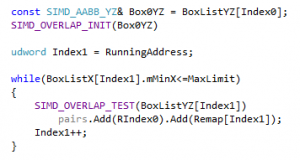


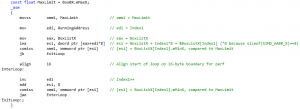


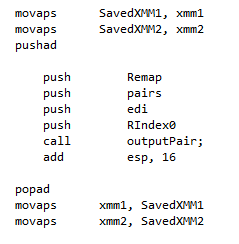
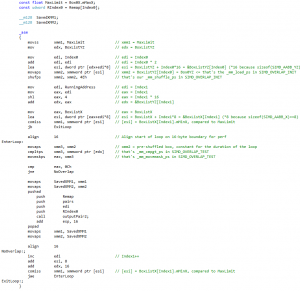
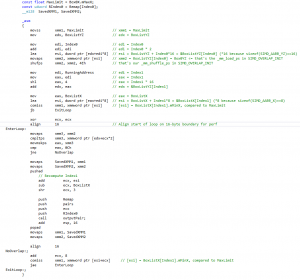
February 15th, 2017 at 10:15 am
… oh. Nevermind then!